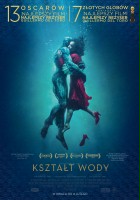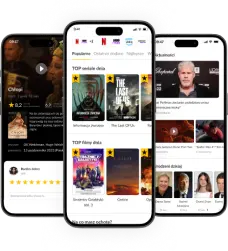Kształt wody
The Shape of Water
2017
- Podstawowe informacje
- Opinie i Nagrody
- Multimedia
- Pozostałe
powrót do forum filmu Kształt wody
(...) Główna bohaterka nie bez powodu zamieszkuje nad starą, kinową salą: "Kształt wody" zbudowany został na filarach fascynacji X muzą. Del Toro hołduje wspaniałym reprezentantom Złotej Ery Hollywood - monster horrorom, jak "Potwór z Czarnej Laguny", a nawet wystawnym musicalom. Można tu postawić pewną paralelę: tak zwana Złota Era była też czasami wielkiego kryzysu gospodarczego, a kino stanowiło rodzaj ucieczki od rzeczywistości. "Kształt wody", podobnie, toczy się w latach kryzysowych, lecz jego bohaterowie odnajdują szczęście w sobie nawzajem. Idylliczna jest nie tylko postawa postaci wobec świata, ale też wizja del Toro. Kierownictwo artystyczne filmu uwodzi szykiem i dystynkcją, choć utopiono "Kształt…" w tonacjach zielono-turkusowych, a więc w melancholii. Brzydota potrafi być urodziwa. Pochodzący z Meksyku reżyser raz jeszcze dowiódł, że ma piękny umysł i obdarzony został wspaniałym talentem oratorskim. Jego najnowsze dzieło urzeka stylem i wrażliwością, pozwala - choć na chwilę - wymknąć się nieprzerwanej gonitwie współczesności. Takiej formy eskapizmu potrzebowaliśmy.
Pełna recenzja: #hisnameisdeath
Cały film, ktoś uznał za symbolikę kinematografii - wklejam analizę, ale po angielsku, znalezioną na movies.stackexchange.com
The vibe I get from Del Toro is that the film is completely representational of cinema and the story therein is a secret condemnation of how the evolved movie machine is attempting to destroy the true artistry of film.
The monster being studio greed, represented by the color green.
The protagonists each represent varying degrees of past film ages OR sometimes literal personifications of it.
Elisa
She's mute - like a silent film. Lives above a movie theater. Both her and Giles have a love for movies. She tap dances and even has a big musical number with The Fish in black and white. Idealistic and romantic and perfect, she's the "Golden Age" of cinema.
“In this movie, Sally [Hawkins] has to look like a real movie star. That was very important for [del Toro]."
Giles
He's the middle "Star Age" of cinema. He's an aging, struggling artist who's own profession is dying out due to being replaced by the new thing. Just like the modern actor who's been replaced by special effects and movie franchises. He orders the green pie because he's drawn to the server, like audiences flocked to theaters to see their favorite actor. Ultimately it's acknowledged the pie is awful and that underneath the shiny, attractive shell of the Server there's no understanding or substance.
Strickland
Not the real villain. But, since he was a kid he's been eating the green candies which has poisoned and twisted him into an evil dude with gangrene. He also hates TEAL and only agrees to buy the car when the salesman tells him it's actually GREEN - color of the future.
He's in charge, so you could make the case he represents the modern Studio Executive who's been corrupted by money and only cares about fulfilling the Studio's will by imprisoning The Fish to abuse, kill and dissect for profit/gain.
Hoffstetler
Like every good film Director, this guy is responsible for managing The Fish while also having to answer to the Studio Executive about it's progress and follows orders. He attempts to work both sides and remains instrumental in saving The Fish. Ultimately though, in the future, he's ultimately discarded -- no longer needed in a harsh future world full of dissection and analytics and data and void of singular artistic voices.
The Fish
The Fish is the personification of film artistry itself who's been ripped from its natural beginnings into a harsh place driven by corporate greed. (Fish = Film). In the end of this incredibly romantic ode however, it's art itself that kills the monster and brings back the Golden Age.
"A tale of love and loss and the monster that tried to destroy it all."
It's in this way that by watching (and supporting) this movie you are helping save film artistry, killing the monster.
Dan Laustsen
The movie was originally supposed to be B/W, a nod to classic film.
He told me about this story, saying, “I have this fantastic story. It’s a love story, a girl and a guy, and the guy’s a fish.” And I was like “What?” [laughs] Of course, when it was black and white, I thought, “Wow, this is fantastic, to shoot a black-and-white movie. It’s like in the old days.”
Jak zaznaczyłem, to nie moja analiza, tylko kogoś z zagranicy - zauważyłem w Twoim poście trafne porównanie filmu do typowego kina Złotej Ery (film ten to hołd dla starego kina klasy B, monster movies, kina surrealistycznego, musicalu, kina szpiegowskiego - to taki tegoroczny "La La Land", tylko bardziej multigatunkowy), dostrzegłem powiązanie i dlatego wkleiłem tą analizę. Jednak film można rozpatrywać pod wieloma aspektami jak o metaforę biblijną, analizę psychologiczno-seksualną, itp. poniżej wkleiam nalize barw w filmie, może Cię zainteresuje:
In Guillermo Del Toro's The Shape of Water, the color green comes up several times, but I feel like I missed something because it never seemed to serve a purpose in the film. Did Del Toro have some specific meaning for the use of the color green throughout the film?
Some specific examples:
When Giles completes his first ad for red Jello, he shows it to his superior who tells him that it needs to be redone with green Jello because 'Green is the color of the future'.
Elisa and Giles eat green Key Lime Pie from the pie shop, but it isn't very good
At one point, Richard Strickland and his family are seen eating green Jello in front of the TV
Strickland buys a new green car, but him and the car salesmen do not agree on what color the car is (Teal vs. Green)
Strickland eats small green candies
Green = mask/lie
Red = true self/truth
Here's incomplete evidence:
Strickland
Strickland eats green candies.
Strickland drives the car everyone keeps calling green (even him when he buys it!).
I think Strickland's house is also green (need to verify this).
(This is gross, but bare with me)
Strickland's fingers are oozing green pus and turning a greenish color for most of the movie, until he gets orders from the general to go all out and hunt down Amphibian Man at all costs. Strickland starts showing his true colors, and at the peak of his transformation, he is righteously reciting a bible verse, at which point he removes his fingers (the green) and blood (red) replaces the green pus color.
Strickland also gets blood/red when he is attacked by the creature, and it's assumed that he was abusing it (showing his true colors).
Giles
Giles creates the poster with red jello, but the people hiring him know he is gay and don't want to work with him. At the same time, they don't want to admit that, so they tell him "green is the color of the future", and promptly deny him the contract/sale, whatever. What I think they were actually saying is "You don't belong here in your true form, and if you had masked yourself to fit in, things would be different."
Every pie Giles gets is a key lime pie (green), until the day he reveals himself to his crush at the pie shop, when he gets (I think) a strawberry pie (a red/orange pie). Once he reveals himself, he is shot down again just like the poster gig.
Elisa
Elisa wears green to her work, until she has sex with Amphibian Man, then she starts wearing red.
Hoffstetler
Bleeds red when he is shot through the cheek. I think this is symbolic of him talking out of the side of his mouth because he is a spy and this happens once he is found out (his true self revealed).
Green is used widely through the “real world” (ie: the lab, the city, her apartment) The movie also mentions that teal is the color of the future/ the man of tomorrow, and specified that it is NOT green. (The Cadillac scene) The colors red and black also seem important as the main character slowly transitions from green clothes to red. Red is also used as a counter/complementary color to the surrounding greens (ie: the exit door to the apartment, glowing red buttons on machinery at the laboratory...) Black seems to be death, the villains fingers slowly turn dead as well as the doctor who is shot wears black head to toe plus a black umbrella (where normally we see him wearing a white lab coat). Minus the black meaning (being a value not a hue) the movie would seem to be shot using a split complementary scheme. (Teal and yellow green with red offsets) but maybe that’s reading too much artsy fartsy into it. I can’t wait to watch it again to decipher even more. Other symbolic references may be the theaters name “Orphium” similar to the story of Orpheus and/or orphan which the main character is. I love the deep methodology the Del Toro brings to his movies and it is always fun to try and decode the color theory for its meanings!



